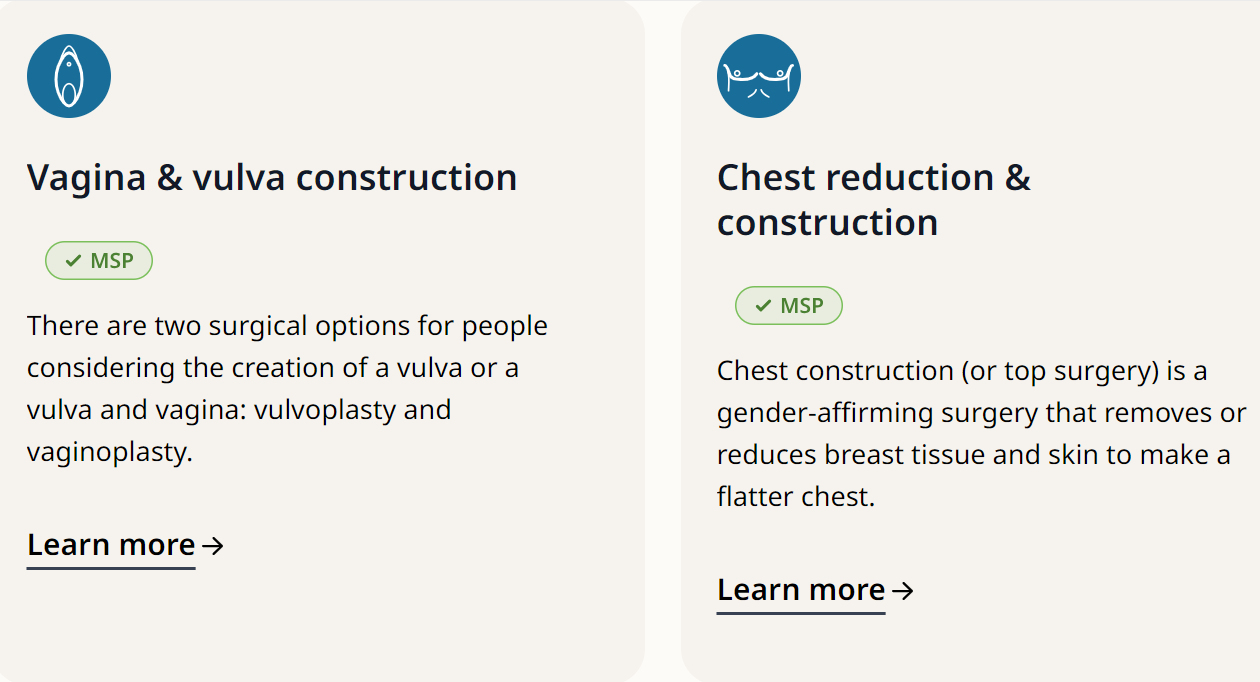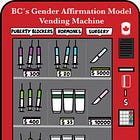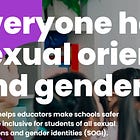Shocking Number of Gender Surgeries in BC
Recent FOI release shows over 2800 girls and women have had their breasts removed.
Information on surgeries available from the Trans Care BC website.
I recently received an FOI requested over half a year ago from the BC Ministry of Health. While some of the contents had little to do with the request (more on that in a separate post), the information it did contain was surprisingly helpful in understanding the scale of gender treatment in BC. The principal document referenced below from the package is Hospital and Provincial Health Services Division - PHSA Supplemental Note - Trans Care BC “Gender Affirming Care: Overarching Care Landscape”, as well as Legislate Session - Estimates Note: Trans Care BC and Gender Affirming Surgery Program.
What is gender treatment?
For those who are unsure what I mean by gender surgeries or why people would be getting them, it all relates to the incoherent idea that people feeling “gender dysphoric” (or that they should have the body of the opposite sex, or even a mix of the two) should, instead of receiving therapy, should try to alter their bodies to become more like the opposite sex.
Gender surgeries are part of a so-called “gender affirmation care” process which generally starts with wrong-sex hormones (testosterone if you’re female and estrogen if you’re a male), or puberty blockers if you’re still young enough, and progresses to breast removal (top surgery) for women and then lower (genital) surgeries for both sexes. Of course, none of this leads to becoming the opposite sex, and while the rate of detransition is not known (because there is no meaningful follow up) surveys suggest it is significant.
More on gender treatment and BC’s continued adherence to this so-called “care” regimen, as well as the story of a detransitioner, can be found in earlier articles, linked below.
The number of gender surgeries in BC
So, what did the Freedom of Information release package say? An internal BC Ministry of Health report provided in the FOI release shows how the number of gender surgeries, both Upper Gender Affirming Surgeries (UGAS) (breast removals and breast reconstruction), and Lower Gender Affirming Surgeries (LGAS) have progressively increased while the wait times have mostly decreased. Trans Care BC, created in 2015, has become the organization which oversees gender-related care and is the treatment pipeline, holding the centralized referral waitlist for surgeries. As per the FOI, since the creation of Trans Care BC the number of UGAS has increased by 138% between 2018 and 2023 while the wait times have decreased. LGAS have been available in BC since 2019 and during this time the number of surgeries has increased, by 122% from 2019-2023.
The types of surgeries included in UGAS are: “chest surgeries”, which are ironically the removal of breasts (lest the term “breast” heighten a patient’s dysphoria), and breast surgeries, which is the construction of breasts for men for whom estrogen has not resulted in desired breast growth. Unfortunately, the number of surgeries is not broken down by age group.
The number of chest surgeries increased from 200 in 2018-2019 to 582 in 2022-2023. Surgeries in 2023-2024 up to P10 (January - tenth month of the fiscal year) are 502. Therefore, 2023-2024 was on track to surpass the previous year by about 20 surgeries. The total number of breast surgeries between 2018 and 2024 (not including those forecasted for 2023-2024) is 2,848.
The number of breast surgeries is much lower but also increased year over year from 2018-2019 with 22 surgeries to 78 in 2022-2023. The number for surgeries up to P10 of 2023-2024 is only 33, so unless a very high number of surgeries was planned for the last two months of the year, the number of breast surgeries went down in the last fiscal year. The total number of breast surgeries from 2018-2024 is 283.
The grand total for UGAS between 2018 and 2024, based on the information available, is 3,131.
Of course, the most serious of these two surgeries is the chest surgery (breast removal), as it is the removal of healthy tissue which, for younger women who have not yet had children, robs them of the ability to breast feed in the future, and robs their future children of breast milk and the mother-child bonding experience. For women who end up leaving their trans identity behind, not having breasts may also be an obstacle to finding a male partner. Breast surgery is also serious, however. Many men are duped into believing that they can somehow embody women by having breast surgery. It is a serious surgery with a risk of complications, and difficult to come back from if they decide to detransition. Both men and women undertaking these surgeries have done nothing more than disfigure their healthy bodies, for the sake of an incoherent ideology.
Now, for genital surgeries, or LGAS. This includes vaginoplasty for men and metoidioplasty and phalloplasty for women (Trans Care BC has a description of these surgeries on their website). Although LGAS appears to only include the former surgeries, women can also have their healthy uterus and ovaries removed.
The number of LGAS increased from 54 in 2019-2020 to 120 in 2022-2023. In 2023-2024 the number of surgeries up to P10 was 103, suggesting that the total could have been around 124. The total number of documented surgeries is 453.
In comparison to chest or breast surgeries, which are already serious, it’s difficult to exaggerate the complexity of LGAS and their potential complications. There are frequent revision surgeries and a high possibility of serious infection. Even the Trans Care BC website lists and impressive number of potential complications. These are not surgeries which anyone can simply undo. And what is the result? Poor facsimiles of actual genitals which do not function as such and are not aligned with a properly functioning reproductive system (i.e., phalloplasty would not be connected with functioning testes).
The growth of gender treatment in BC
What we need to remember is that these totals only go back to 2018 for UGAS and 2019 for LGAS. Before 2019, LGAS were carried out in Montreal. The actual total number of people in BC who have had gender surgery is much higher. However, the gatekeeping for these surgeries has decreased over time while the availability has increased. As noted in the FOI, since the latest standards of care were published in 2022 by WPATH (version 8), the following changes have been made:
Only one surgical assessment, instead of two, is now advised for all gender-affirming genital surgeries.
A former ‘congruent living’ requirement was removed.
The length of recommended hormone therapy prior to genital surgeries for adults, if indicated, was reduced from one year to six months.
For anyone just learning about this issue, they might wonder where it started and how it picked up momentum. While I won’t get into details here, it appears that trans ideas really began to circulate more widely and have an impact on the younger population in the early 2010s. With the exposure to trans ideas increasing in the mid 2010s, the number of young people in particular seeking gender treatment increased dramatically, and as noted by Dr. Lisa Littman in 2018, in the US the number of females presenting at gender clinics surpassed the number of males, inverting the previous trend. Littman also found that social contagion was a key cause of the increase in girls claiming to be trans. What was almost assuredly propelling this was wider media exposure to trans ideas through network shows such as I Am Jazz, which premiered in 2015, and also through social media platforms such as TUMBLR. In BC, SOGI 123 lessons had been rolled out in schools starting in 2016, with curriculum which undermines the objective reality of sex and promotes gender ideology concepts. So, it’s not really surprising that by 2018 the number of referrals for gender surgeries in BC started to take off.
Also impacting the growing number of surgeries was how gender treatment became focused solely on medicalization. For those experiencing gender confusion, Trans Care BC (TCBC) Health Navigators help prospective patients find treatment which stresses medicalization. While there may be access to counselling, it is meant to be purely affirmative and does not challenge patients’ ideas that they are either non-binary or trans. This isn’t surprising given that in 2022 attempting to change anyone’s gender identity became illegal in Canada with the passing of Bill C-4. So even if counsellors wanted to help patients find their way out of gender confusion, they would be charting dangerous waters by doing so. Without patients being able to seriously delve into their psychological issues or challenge their own beliefs, they are inevitably being put on track to be medicalized.
In 2022-2023 TCBC Health Navigators handled 6,000 cases, up 18% from the previous year. This means that in the same year that 6,000 cases were handled, an equivalent of 13% (780) had surgery. This does not include the number of minors and adults put on hormones. As stated in the FOI:
Transition-related medical interventions: Depending on the client’s needs and goals, the patient may begin with assessment for hormone therapy, and then may progress to surgery and post-operative care.
There’s no diagnosis in this process at all. The process, as indicated here and on the TCBC website, is wholly in the hands of the patient, potentially with the exception of those presenting with extreme mental or physical health complications. It is hardly surprising that when children, youth, and adults are bombarded by information which supports medicalized gender treatment in the media, social media, and governmental medical institutions such as TCBC, and then the patients themselves are put in charge of diagnosis and choosing their own treatment path, of course the number of patients will increase over time as shown generally by the statistics found in the FOI.
And now we are in a situation where over 2,800 girls and women have had their healthy breasts amputated in BC since 2018. In BC, where the population of women between 15 and 49 (those I would consider most likely to have undertaken chest surgery) is 1,113,785; this equals 2.5 women per 1,000. Again, this does not include those on hormones, which is the first step in the medicalization pathway and which can irrevocably alter one’s appearance, voice, and health and often leads to surgeries.
Impact on health resources
In addition to the obvious harm that these surgeries cause, the impacts to our healthcare system and the healthcare budget are not to be understated. One way that the impact of these surgeries on the system is indicated is through wait times. The FOI clearly shows the Ministry’s drive to shorten wait times for gender surgeries. For LGAS, the Ministry acknowledges that the wait period is relatively long, and no target number of weeks was provided. For UGAS, the target number of weeks for completion is 26, within which 93% of chest surgeries, and 85% of breast surgeries were completed. In 2018 TCBC took over the gender surgery waitlist in an effort to streamline it. (It should be noted that mastectomies required for health reasons have a wait time of about 6 weeks according to BC Surgery Wait Times.)
So, within just over 6 months of being referred, individuals can get breast or chest surgery. For comparison, according to the BC Surgery Wait Times, 90% of the following surgeries are completed within much longer timeframes, some over a year:
Hip replacements - 52 weeks
Knee replacements - 57.9 weeks
Foot/ankle surgeries - 56.4 weeks
I understand that the surgeons working on breast and chest surgeries are not the same as those working on joint surgeries, and so the impact on these particular surgeries wouldn’t be direct. However, budget is still being rerouted to gender surgeries, operating room time, nursing time, supplies and materials. And while this may not be the case, it certainly appears that UGAS are a higher priority than replacing seniors’ hips and knees which could be causing considerable pain.
In terms of costs, the core funding allotted to Trans Care BC is a total of $6.4 million annually. Of that, $2.4 million goes to the Gender Surgery Program which includes $300,000 strictly for pre-LGAS hair removal. This does not appear to cover surgery costs, which are billed to the Medical Services Plan (MSP). Calculating the private-pay costs of UGAS cited on the TCBC website of $10,000 per surgery in 2021-2022, the total would be $6.6 million. For LGAS, based on costs cited on the Healthline website, each surgery could cost about $50,000. The total for LGAS based on the number of surgeries in 2021-2022 would be another $6.6 million. Even if the cost of these surgeries were half that amount, the total would be more than the annual budget for TCBC.
Put all together, if the surgery costs are about correct, the total costs of TCBC plus the actual surgeries could be $19.6 million. Nearly $20 million annually, potentially, for surgeries that in no way have been proven to be needed or have a corresponding diagnosis. Nearly $20 million for surgeries which individuals, even minors, can be referred for without having anything wrong with them besides their mental health.
Where do we go from here?
According to the FOI, the number of referrals for surgery appears to be plateauing over the last two fiscal years. This presents some very limited hope that the trans ideas are not as virulent a social contagion as they once were. However, there is no denying that our health system is still eager to race as many patients to their surgeries as possible by reducing wait times. Minors and adults alike are being allowed to diagnose themselves while the Ministry of Health helps them to harm their own healthy bodies by encouraging surgeries. It goes without saying that the ministry needs to look at the evidence reviews coming out of Europe and reconsider these treatments. However, the ministry also needs to look itself in the mirror and ask why this is the only treatment course which requires no diagnosis beyond the vague “gender dysphoria”, although even that is declining in favour of viewing gender treatment as a form of self-actualization and a human right. Medicine as an option and not as a cure has to end in order to stop these treatments from causing more harm.










Thanks for doing this. Still leaves me reeling that this kind of basic public informative work is not touched by conventional journalists, that citizen journalists have to reinvent that wheel on their own.
Breaks my heart.